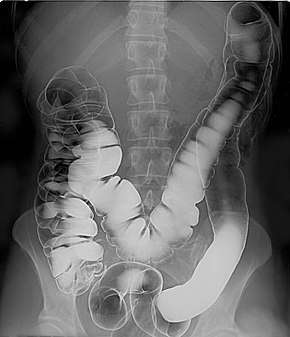Double-contrast barium enema
A double-contrast barium enema is a form of contrast radiography in which x-rays of the colon and rectum are taken using two forms of contrast to make the structures easier to see.[1] A liquid containing barium (that is, a radiocontrast agent) is put into the rectum. Barium is a silver-white metallic compound that outlines the colon and rectum on an x-ray and helps show abnormalities. Air is also put into the rectum and colon to further enhance the x-ray.
| Double-contrast barium enema | |
|---|---|
| Medical diagnostics | |
 Human intestinal tract, as imaged via double-contrast barium enema | |
| Purpose | radiography which uses 2 forms of contrast for better image |
Double-contrast barium enemas are less invasive than a colonoscopy and have comparatively fewer issues in a viable large bowel.[2]
References
- Cittadini, Giorgio (2012). Double contrast barium enema: The Genoa approach. Springer Science & Business Media. p. 5. ISBN 9788847022171.
- Stringer, David A.; Babyn, Paul S. (2000). Pediatric Gastrointestinal Imaging and Intervention. PMPH-USA. p. 38. ISBN 9781550090796.
External links
- Double-contrast barium enema entry in the public domain NCI Dictionary of Cancer Terms
![]()
This article is issued from
Wikipedia.
The text is licensed under Creative
Commons - Attribution - Sharealike.
Additional terms may apply for the media files.